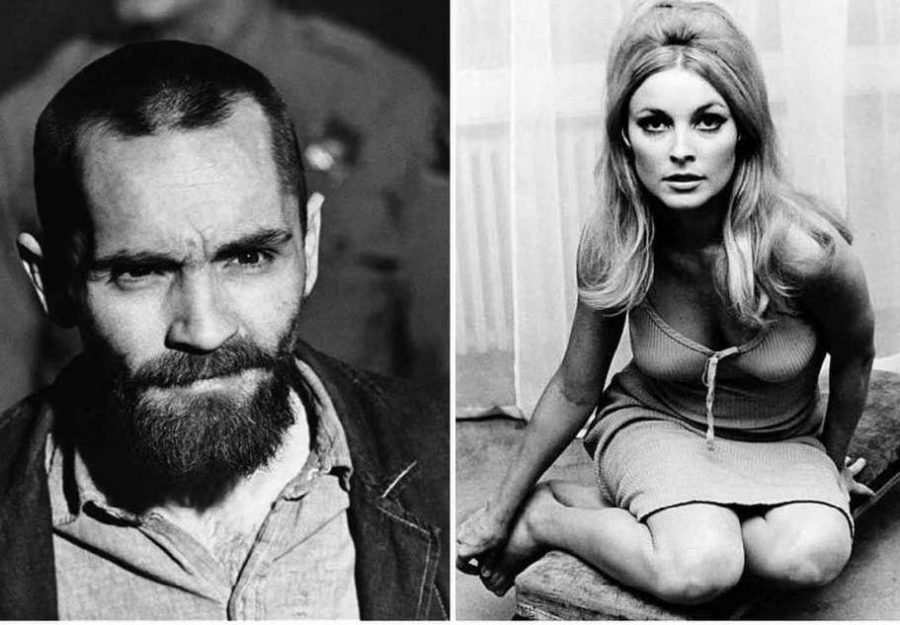Dissecting Tarantino’s Once Upon a Time in Hollywood
Charles Manson and Sharon Tate, played in the film by Damon Herriman and Margot Robbie respectively. Courtesy of the New Haven Register.
September 26, 2019
Eccentric director Quentin Tarantino has been at the helm of quirky cult films since the early ’90s. His filmography includes such classics as “Reservoir Dogs,” “Kill Bill,” “Pulp Fiction,” “Django Unchained” and “The Hateful Eight,” and he doesn’t appear to be slowing down anytime soon. His latest film “Once Upon A Time in Hollywood” follows the commercial haze of 1969 film society and the figures it interweaves, including but not limited to Charles Manson, Roman Polanski and Sharon Tate. The star-studded cast includes Margot Robbie, Margaret Qualley, Dakota Fanning, Austin Butler, Bruce Dern, Al Pacino, Timothy Olyphant, Emile Hirsch, Leonardo Di Caprio and Brad Pitt.
The movie opens into the reel of an interview between Di Caprio and Pitt; an actor and his stunt double starring in the skipping black and white era of the Western, cigarette burns and all. Tarantino experiments with storytelling strategies by piling various cinematic styles beside and on top of one another. Tarantino’s fumbled patchwork quilt of cinema is endearing in some ways, but mostly it is just overwhelming, and alarmingly reliant upon the much-dreaded voice over.
Barbara Ling’s set design flawlessly carries the viewer into 1969 with her precise attention to detail. Each set in the film is gracefully and carefully created through a vibrant balance of the miniscule and the grand. Aesthetically, the film is incredibly satisfying, with the work of Ariane Phillips wrapping each actor in the fabric of the past.
For a film that is often referred to as “that movie about the Manson murders” the plot barely touches Charles Manson’s cult, nor their original motivations. Tarantino plays on the national intrigue, fascination, and hatred for a typical American villain that has only grown in the past 50 years.
By only revealing the mastermind directing the Manson debauchery for just a few seconds in the film, Tarantino makes a skilled choice that allows for Charles Manson’s character to create unrest within the viewer. If Tarantino had included dramatized portrayals of the horrific cult leader, it would not have had an ounce of the power that he slipped in to the film by only allowing the audience a glimpse into this world of manipulation, death, and destruction that we already know so well. The viewers are familiar with Manson’s crimes, and heartbeats quicken and the viewer’s skin crawls as a well-mannered man stumbles out of an ice cream truck, scouting out 10050 Cielo Drive.
Margaret Qualley drips in the long-haired, barefoot, dumpster diving allure of the archetypical hippie revolutionary. Qualley and her flock of doe-eyed deviants are introduced to Pitt as they glide by, hitchhiking and humming, spirits that create an aura of beauty and kindness. Qualley leads Pitt, playing stuntman Cliff Booth, to the ranch in which the remainder of the cult resides.
Booth considers getting lost between the long unshaved legs of Qualley, known in the film as Pussycat, but casually insinuates that as he has already evaded any chance of prison for the murder of his wife, he wouldn’t put himself at risk in broad daylight for any old nymphet. She swiftly shifts from his newfound, spun, quicksilver girl – an angel who is wild for this strange older man – into a shrieking Banshee muddled by Manson’s longreaching, acid-dipped fingertips. Mikey Madison is the enhanced vision of the delusional murderess, playing the erratic Sadie, torched by a flamethrower at the hands of Di Caprio’s Cliff Dalton at the close of the film.
Once Upon A Time in Hollywood is worth the watch, a kaleidoscopic film with a few scratches on the glass, but a beautiful image all the same.







